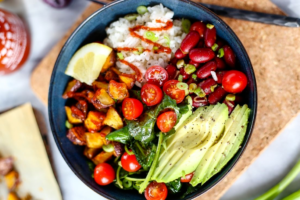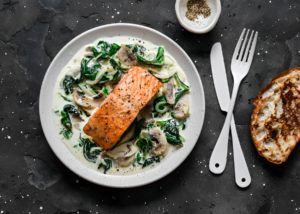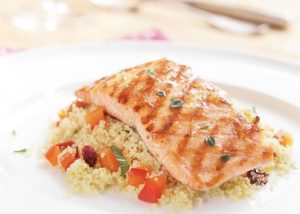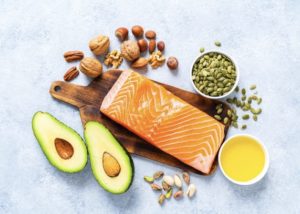- Home
- /
- Healthy Meal
- /
- Recipes of Healthy Food
- /
- Breakfast
- /
- Sandwiches and Healthy Eating
- /
- Sandwiches and Healthy Eating:...
In the culinary world, few creations are as versatile, satisfying, and universally beloved as the humble sandwich. Whether tucked between slices of bread, cradled within a warm, crusty baguette, or ensconced in a tender wrap, sandwiches have an enduring appeal that transcends cultural boundaries and dietary preferences. These portable and customizable delights are not only a testament to the art of layering flavors but also a canvas for culinary innovation.
The beauty of sandwiches lies in their adaptability. From towering deli-style classics to creatively reimagined recipes, sandwiches can cater to every palate, dietary need, and culinary curiosity. And in today’s health-conscious world, the marriage of sandwiches and healthy eating has never been more celebrated.
This article delves into the world of sandwiches and healthy eating, exploring the origins and evolution of the sandwich, dissecting the anatomy of a nutritious and satisfying creation, and unveiling a collection of innovative and wholesome sandwich recipes. Join us on this delectable journey as we discover how sandwiches can be a delightful union of flavors, textures, and nutrition that caters to your well-being while tantalizing your taste buds.
1. The History of Sandwiches
Before we dive into the culinary aspects of sandwiches, it’s important to explore their history. Discover how this simple yet ingenious meal option has evolved over centuries.
1.1. The Origins of the Sandwich
The Tale of the Gambling Earl
The story of the sandwich’s inception is a fascinating journey back in time to 18th-century England. It all begins with John Montagu, the 4th Earl of Sandwich, a man with a passion for gambling and an aversion to leaving the card table. As the tale goes, Montagu was deeply engrossed in a marathon gambling session one evening, and rather than abandoning his cards for a formal meal, he requested his servant to bring him some slices of roast beef placed between two pieces of bread. The concept was simple yet revolutionary – it allowed him to continue playing without the inconvenience of using utensils or soiling his hands. And just like that, the first “sandwich” was born.
The Birth of the ‘Sandwich’
The innovation was not lost on his fellow gamblers, who quickly embraced this convenient, hand-held meal. Word of the Earl of Sandwich’s creation spread like wildfire, and before long, people were ordering “the same as Sandwich” when requesting the novel dish. It wasn’t long before the term “sandwich” became a part of the English language, and the concept took root.
A Culinary Invention with Global Roots
Yet, the notion of combining meat and bread was not exclusive to England. In various cultures around the world, similar concepts had been in practice for centuries. From the Mexican torta to the Vietnamese bánh mì, and the Italian panino, the idea of wrapping delicious fillings in bread has been a culinary staple in many societies.
The Sandwich’s Enduring Legacy
As we delve into the origins of the sandwich, it becomes clear that this ingenious culinary creation was not the result of a single eureka moment but rather a gradual evolution. It was a testament to the human desire for convenience, portability, and flavor. The simple sandwich, born out of a card game, has since become a global phenomenon, adapting to the tastes, traditions, and dietary needs of countless cultures. The legacy of John Montagu, the Earl of Sandwich, endures in every sandwich enjoyed today, a testament to the enduring appeal of this iconic and adaptable dish.
1.2. The Evolution of Sandwiches
The sandwich, a culinary delight that now graces menus and dining tables worldwide, has a rich and diverse history of evolution. While the Earl of Sandwich’s eureka moment in the 18th century was a pivotal milestone, the concept of sandwich-like creations can be traced back through the annals of time, revealing a fascinating journey through different cultures and eras.
Ancient Precursors
Sandwich-like foods were consumed in ancient civilizations, long before the term “sandwich” was coined. In ancient Egypt, for instance, people enjoyed flatbreads filled with a variety of ingredients, resembling a distant ancestor of the modern sandwich. The portability and convenience of these early incarnations foreshadowed the enduring appeal of sandwiches.
Middle Eastern Influence
The Middle East played a significant role in the development of sandwiches. Pita bread, for instance, has been used for centuries to wrap various fillings, such as falafel, shawarma, and kebabs. These early “wraps” were, in essence, a manifestation of the same principles that define the modern sandwich: combining flavorful ingredients within a convenient bread casing.
European Adaptations
As trade routes expanded and interconnected, so did the exchange of culinary traditions. In Europe, the concept of encasing ingredients within bread gained traction. In France, they created the croque-monsieur, a delightful blend of ham and cheese, while the Italians introduced the panini. The English ploughman’s lunch, with its hearty mix of bread, cheese, and pickles, further exemplified the sandwich’s versatility.
International Sandwich Variations
The sandwich concept continued to evolve around the globe. In the Americas, the Mexican torta embraced a fusion of flavors, incorporating meats, vegetables, and distinctive salsas in a soft roll. In Vietnam, the bánh mì blended French baguette influence with Vietnamese ingredients, creating a harmonious East-West flavor fusion. These examples underscore the adaptability of the sandwich, capable of absorbing and enhancing diverse culinary traditions.
The Sandwich Today
In the modern era, the sandwich has become a canvas for culinary experimentation. Chefs and home cooks alike continue to innovate with fresh ingredients, artisanal bread, and global flavors. From gourmet sandwiches with specialty ingredients to plant-based creations that cater to evolving dietary preferences, the sandwich remains a symbol of versatility and adaptation.
The sandwich’s evolution is a testament to its timeless appeal. It has transcended cultural boundaries and continues to adapt, ensuring its place as a beloved and enduring culinary concept. As we explore the history of sandwiches, it becomes evident that they are not just a meal but a reflection of the ever-evolving human palate and the ingenuity that emerges when flavors and convenience unite.
2. The Anatomy of a Healthy Sandwich
Now that we’ve established the historical context, it’s time to delve into the core of this article: crafting a healthy sandwich.
2.1. Bread Selection
When crafting the perfect healthy sandwich, one of the most crucial decisions you’ll make is the choice of bread. The type of bread you select sets the foundation for your entire sandwich, impacting not only its taste but also its nutritional profile. Let’s dive into the world of bread and explore the various options available to ensure your sandwich aligns with your health-conscious goals.
a. Whole-Grain Wonders
Whole-grain bread is a top choice for those seeking a nutritious foundation for their sandwich. It’s made from flour that includes the entire grain, which means it retains all the essential nutrients and dietary fiber. The result is a bread that not only offers a rich, nutty flavor but also provides a steady release of energy, keeping you full and satisfied for longer. Whole-grain bread is packed with vitamins, minerals, and antioxidants, making it an excellent choice for a well-rounded and healthy sandwich.
b. Multigrain Magic
Multigrain bread, as the name suggests, is crafted from a variety of grains and seeds. This diverse blend not only adds a delightful texture and taste to your sandwich but also provides an array of nutrients. With the combined goodness of wheat, oats, flaxseeds, and more, multigrain bread offers a medley of flavors and a range of health benefits. It’s an ideal choice for those looking to add variety and extra nutrition to their sandwiches.
c. Gluten-Free Goodness
For individuals with gluten sensitivities or celiac disease, the availability of gluten-free bread is a game-changer. These bread options, often made from rice, quinoa, or almond flours, allow those with dietary restrictions to enjoy sandwiches without discomfort. However, it’s essential to be mindful of the ingredients in gluten-free bread to ensure they are as nutritious as their gluten-containing counterparts.
d. Low-Carb Alternatives
In an era of low-carb diets, many people opt for bread with reduced carbohydrate content. Bread made from almond flour, coconut flour, or even vegetables like cauliflower can be a fitting choice for those watching their carb intake. These options are not only low in carbs but also offer unique and savory flavors to enhance your sandwich.
e. Artisanal and Specialty Breads
If you’re looking to elevate your sandwich experience, consider exploring artisanal and specialty bread. These options often feature unique ingredients like olives, herbs, or whole seeds. The craftsmanship and attention to detail that go into these breads can transform a simple sandwich into a gourmet delight.
f. Portion Control Matters
Regardless of the type of bread you choose, it’s essential to practice portion control. Overloading your sandwich with excessive bread can lead to unnecessary calories and carbs. Keep an eye on the size of your bread slices and consider open-faced sandwiches as a way to reduce your bread intake while still savoring the flavors.
In the world of healthy sandwich-making, the choice of bread is a crucial step. Each type of bread brings its own unique character and nutritional benefits to your sandwich. By selecting the right bread for your dietary preferences and taste preferences, you’re well on your way to creating a sandwich that not only satisfies your hunger but also supports your commitment to healthy eating..
All-round information about bread read in the article: The Bread Dilemma: Friend or Foe in Health
2.2. Protein Choices
The protein component of your sandwich is not only essential for satiety but also plays a pivotal role in the overall nutrition and flavor of your creation. When it comes to crafting a healthy sandwich, choosing the right protein sources can make all the difference. Let’s explore a variety of protein options that can elevate your sandwich to a whole new level of delicious and nutritious.
a. Lean Meats: The Classic Choice
Traditional sandwich fillings often include lean meats such as turkey, chicken, roast beef, and lean ham. These protein sources are not only low in fat but also high in essential nutrients like protein, iron, and B vitamins. When selecting deli meats, opt for low-sodium or nitrate-free options to keep your sandwich heart-healthy.
b. Plant-Based Alternatives
With the surge in popularity of plant-based diets, there’s an array of protein-rich plant-based options for your sandwich. Consider items like tofu, tempeh, or seitan as meat substitutes. Additionally, legumes such as chickpeas, black beans, and lentils can be mashed or used whole to create flavorful and protein-packed spreads or fillings.
c. Seafood Sensations
Seafood offers a fantastic twist for those craving a lighter yet still protein-rich option. Salmon, tuna, or grilled shrimp can provide a delectable flavor profile to your sandwich. Not only do these choices deliver a dose of lean protein, but they also bring the benefits of omega-3 fatty acids for heart and brain health.
d. Egg-cellent Choices
Eggs are a versatile and protein-rich addition to any sandwich. Whether you prefer hard-boiled, scrambled, or poached eggs, they bring a delightful creaminess and added protein to your creation. You can also consider egg salad as a classic sandwich filling.
e. Dairy Delights
Dairy products like cheese and yogurt can contribute a creamy, protein-rich element to your sandwich. Cottage cheese, Greek yogurt, and low-fat cheese varieties are excellent choices. These ingredients not only boost your sandwich’s protein content but also add a satisfying texture and taste.
f. Nuts and Seeds
If you’re seeking a plant-based protein boost with a satisfying crunch, nuts and seeds are a remarkable choice. Sliced almonds, walnuts, or sunflower seeds can be sprinkled on your sandwich, or you can spread almond or peanut butter for a flavorful twist. These options also introduce healthy fats and additional nutrients to your meal.
g. Combining Proteins
Don’t be afraid to mix and match protein sources. Combinations like turkey and avocado, hummus and grilled chicken, or a classic BLT with bacon and eggs offer a range of flavors and textures that can transform your sandwich into a gourmet experience.
When it comes to protein choices for your healthy sandwich, the options are as diverse as your culinary imagination. Consider your dietary preferences, nutritional goals, and taste preferences as you select your protein sources. Whether you opt for classic lean meats, embrace the plant-based revolution, or combine different elements, the right protein choice can turn your sandwich into a wholesome and delicious meal that satisfies both your palate and your body’s nutritional needs.
Read more about protein here: Proteins and Healthy Eating: The Marvels of Molecular Machines
2.3. Fresh Ingredients
The success of a healthy sandwich hinges on the quality and variety of fresh ingredients you select. Fresh components not only contribute to the sandwich’s flavor but also provide a wealth of essential vitamins, minerals, and dietary fiber. Let’s explore the world of fresh ingredients and how they can transform your sandwich into a nutritional powerhouse.
Colorful Vegetables: The Crisp and Crunchy Core
Fresh vegetables are the lifeblood of a healthy sandwich. Whether it’s vibrant lettuce leaves, juicy tomato slices, crisp cucumber rounds, or peppery radish slivers, vegetables add a spectrum of flavors, textures, and nutrients to your creation. Not only do they enhance the taste, but they also provide vitamins and antioxidants that promote good health.
About fruits and vegerables get known here: Fruits and Vegetables: Abundant Palette of Healthy Eating
Herbs and Greens: Fresh and Flavorful
Elevate your sandwich with a bouquet of fresh herbs and greens. Basil, cilantro, arugula, and spinach can add layers of aroma and taste. These greens not only enliven your senses but also offer essential vitamins, minerals, and a burst of freshness to each bite.
Onions and Garlic: A Zesty Zing
Onions and garlic, whether raw or sautéed, can infuse your sandwich with a bold, savory kick. Beyond flavor, they contribute health benefits like immune system support and cardiovascular wellness.
Avocado: Creamy Goodness
Avocado is a rich and creamy addition that brings a velvety texture and a wealth of healthy fats to your sandwich. It’s packed with monounsaturated fats, vitamins, and fiber, making it an excellent choice for those who want a more substantial and satiating sandwich.
Sprouts and Microgreens: A Nutrient Punch
Sprouts and microgreens are tiny powerhouses of nutrition. These delicate greens provide concentrated vitamins, minerals, and enzymes in each bite. They are a delightful way to add a burst of freshness and health to your sandwich.
Pickles and Fermented Delights
Pickles, sauerkraut, or kimchi can be a unique addition to your sandwich. These fermented ingredients not only add a tangy contrast but also introduce probiotics that support gut health. As a bonus, they provide a zesty note that can enhance your sandwich’s overall taste.
Fresh Fruits: Sweet and Savory Twists
Fresh fruits can provide an unexpected, sweet-and-savory twist to your sandwich. Slices of apple or pear can add a delightful crunch, while figs or strawberries can lend a touch of sweetness. These fruity elements not only create intriguing flavor combinations but also offer a range of vitamins and antioxidants.
When it comes to assembling a healthy sandwich, fresh ingredients are the cornerstone of both taste and nutrition. By incorporating a colorful array of vegetables, herbs, and greens, along with unique additions like avocado or pickles, you can turn your sandwich into a vibrant and wholesome masterpiece. The key lies in the combination of flavors and textures, ensuring that every bite is a delightful journey for your taste buds and a source of essential nutrients for your well-being. evate your sandwich’s nutritional value.
2.4. Spreads and Condiments
Spreads and condiments are the flavor boosters of a sandwich, and while they can add excitement and zest to your creation, they can also be a hidden source of excess calories, sugar, and unhealthy fats. Choosing the right spreads and condiments is pivotal to creating a healthy sandwich that’s both delicious and nutritious. Let’s explore a range of options that balance flavor and health.
Hummus: Creamy, Nutrient-Rich Bliss
Hummus, a creamy blend of chickpeas, tahini, lemon, and garlic, is a versatile and nutritious spread. It offers plant-based protein, fiber, and a unique, earthy flavor that pairs well with vegetables, meats, or as a base layer for your sandwich.
Avocado Spread: Heart-Healthy Goodness
Avocado spread is a delicious and nutritious alternative to traditional spreads. Rich in monounsaturated fats, avocados offer a creamy texture, a mild taste, and a wealth of vitamins, minerals, and fiber. Spread it generously on your bread for a luscious and heart-healthy foundation.
Mustard: Tangy and Low in Calories
Mustard is a classic sandwich condiment that adds a tangy kick without adding significant calories or unhealthy fats. Opt for Dijon, whole grain, or spicy varieties to elevate the flavor of your sandwich.
Greek Yogurt: Creamy and Probiotic
Greek yogurt is a versatile condiment that provides creaminess along with probiotics that support gut health. Use it as a base for creamy spreads, or mix it with herbs and spices for a delectable dressing.
Pesto: A Burst of Flavor
Pesto, made from fresh basil, pine nuts, Parmesan cheese, garlic, and olive oil, is a flavorful option that adds a burst of taste to your sandwich. While it’s calorie-dense due to the healthy fats, a little goes a long way in terms of flavor.
Salsa: Fresh and Zesty
Salsa offers a low-calorie, low-fat option that’s brimming with flavor. It’s an excellent choice for those who prefer a lively, zesty kick to their sandwich. The combination of tomatoes, onions, cilantro, and chili peppers adds a refreshing element to your creation.
Olive Tapenade: Mediterranean Magic
Olive tapenade is a savory spread made from a mixture of olives, capers, and olive oil. It brings a Mediterranean flair to your sandwich, infusing it with the rich, briny taste of olives and a dose of healthy monounsaturated fats.
Nut Butters: Protein and Flavor
Nut butters like almond, peanut, or cashew can be a unique and protein-rich addition. They offer a creamy, nutty flavor along with healthy fats and essential nutrients. Just be mindful of portion sizes to avoid calorie overload.
The spreads and condiments you choose should complement the other ingredients in your sandwich, enhancing both taste and nutrition. By opting for options like hummus, avocado, mustard, or Greek yogurt, you can elevate your sandwich without compromising its healthiness. Keep in mind that moderation is key, as some spreads and condiments, while delicious, can be calorie-dense. Ultimately, the perfect balance of spreads and condiments can transform your sandwich into a symphony of flavors and a nutritious meal that tantalizes your taste buds.
2.5. Healthy Fats
While fats have earned a reputation for being unhealthy, it’s essential to distinguish between the types of fats and their role in a balanced diet. Healthy fats are a crucial component of a wholesome sandwich, providing satiety, flavor, and essential nutrients. Let’s delve into the world of healthy fats and how they can be integrated into your sandwich to make it both delicious and nutritious.
Avocado: Creamy and Heart-Healthy
Avocado is a superstar in the world of healthy fats. Its creamy texture is perfect for spreading on bread or adding slices to your sandwich. Avocado is rich in monounsaturated fats, which are known for their heart-protective benefits. It also provides essential vitamins, such as vitamin K and folate, making it a nutritious addition to your sandwich.
Nuts and Seeds: Crunchy Nutrient Bombs
Nuts and seeds like almonds, walnuts, chia seeds, and flaxseeds bring a delightful crunch to your sandwich while delivering healthy fats, fiber, and a wealth of essential nutrients. A sprinkle of chopped nuts or a smear of nut butter can provide a satisfying texture and nutty flavor to your creation.
Olive Oil: Liquid Gold
Olive oil is a staple of Mediterranean cuisine and a source of heart-healthy monounsaturated fats. Drizzle a bit over your sandwich or use it as a base for dressings and spreads. It not only enhances the taste but also offers anti-inflammatory properties and antioxidants.
Fatty Fish: Omega-3 Powerhouses
Fatty fish like salmon, mackerel, and trout are a flavorful source of omega-3 fatty acids, which are well-known for their brain and heart health benefits. Including grilled or smoked salmon in your sandwich can provide a savory, flaky richness along with these essential fats.
Coconut: Unique Flavor and Healthy Fats
Coconut, in various forms like shredded coconut or coconut oil, can be used to infuse your sandwich with a tropical, sweet, and nutty flavor. While it’s a saturated fat, coconut offers medium-chain triglycerides (MCTs), which are metabolized differently than other saturated fats and may offer unique health benefits.
Tahini: Creamy Sesame Goodness
Tahini, a paste made from ground sesame seeds, is a Middle Eastern delight that adds creaminess and nuttiness to your sandwich. It’s a rich source of healthy fats, along with vitamins and minerals like calcium and iron.
Nut Butter Alternatives: Beyond Peanuts
Beyond peanut butter, you can explore alternatives like almond butter, cashew butter, or sunflower seed butter. These options provide a diverse range of flavors and healthy fats, allowing you to tailor your sandwich to your preferences.
Incorporating healthy fats into your sandwich not only enhances its taste but also contributes to a satisfying, balanced meal. Avocado, nuts, olive oil, and other sources of healthy fats bring a wealth of benefits, from heart health to brain function. The key is to use them in moderation and in harmony with other nutrient-dense ingredients, creating a sandwich that’s a testament to the delicious synergy of wholesome components.
2.6. Portion Control
While selecting the right ingredients for your sandwich is undoubtedly essential, maintaining portion control is equally crucial when it comes to crafting a healthy meal. It’s all too easy to go overboard and inadvertently turn a nutritious sandwich into a calorie-laden behemoth. Let’s explore the importance of portion control and some strategies to help you savor your sandwich without overindulging.
Mindful Assembly
Building your sandwich with mindfulness can be your first step towards portion control. Start with a reasonable amount of your chosen bread as the base. Then, layer your proteins, veggies, and spreads evenly, making sure not to overload any one component. This balanced approach ensures that each bite offers a delightful combination of flavors and nutrients.
Open-Faced Options
Open-faced sandwiches, which consist of a single slice of bread with toppings, are an effective way to cut down on bread and control portion size. This approach allows you to savor the ingredients without the added calories and carbs of a second slice.
Choose Smaller Bread
Opt for smaller bread options, such as slider rolls or mini pita pockets, to naturally control portion sizes. These smaller versions still provide the satisfaction of a sandwich without the risk of overeating.
The Half-Sandwich Solution
Another effective strategy is to make a half-sandwich. Pair your sandwich with a hearty side salad, a cup of vegetable soup, or a piece of fruit to create a balanced meal without the need for a full-sized sandwich.
Consider Wraps and Lettuce Cups
Wraps made with whole-grain tortillas or lettuce cups can be a creative and portion-controlled alternative to traditional bread. They naturally limit the amount of filling you can add and offer a lighter, lower-carb option.
Pack Snack-Size Portions
If you’re making sandwiches for on-the-go, consider portioning your ingredients into snack-size containers. This not only prevents overindulgence but also makes for a convenient, grab-and-go lunch option.
Enjoy a Side of Satiety
Include high-fiber, protein-rich sides like raw vegetables, Greek yogurt, or a handful of nuts with your sandwich. These sides can help you feel full and satisfied with a smaller portion of the sandwich itself.
Portion control isn’t about deprivation; it’s about finding the right balance. By being mindful of the quantity of each ingredient and exploring strategies like open-faced sandwiches, smaller bread, or half-sandwich options, you can relish the flavors of your sandwich without consuming excessive calories or carbohydrates. The goal is to enjoy your sandwich to the fullest while maintaining a healthy and nutritious balance that aligns with your dietary goals and overall well-being.
3. Nutritional Considerations
To truly embrace healthy eating through sandwiches, it’s crucial to understand the nutritional aspect. This section will provide insight into making informed choices.
3.1. Calories and Macronutrients
Understanding the calorie and macronutrient composition of your sandwich is a fundamental aspect of ensuring that it aligns with your healthy eating goals. Whether you’re counting calories, tracking macronutrients, or simply aiming for a balanced diet, it’s essential to have a grasp of what’s on your plate. Let’s break down the key considerations regarding calories and macronutrients in your sandwich.
Balancing Act: Calories
The calorie content of your sandwich is a direct measure of the energy it provides. To maintain a healthy weight, it’s important to balance the calories you consume with the calories you burn through physical activity. Keeping an eye on portion size and ingredients can help you create a sandwich that doesn’t tip the scales when it comes to calorie intake.
To count or not to count calories read here: Calories: To Count or Not to Count?
Protein: The Building Block
Protein is a vital macronutrient in your sandwich, responsible for a range of essential functions in your body. It promotes muscle growth, supports immune function, and helps you feel fuller for longer. By including an adequate amount of lean protein in your sandwich, you can enhance its nutritional value and stay satisfied throughout the day.
About proteins-fats-carbs ratio and why is it important get known here: Proteins Fats Carbohydrates Ratio in Healthy Eating: Why matters
Carbohydrates: Energy Source
Carbohydrates are the primary source of energy for your body. Whole grains, fruits, and vegetables provide complex carbohydrates, which release energy steadily and help maintain blood sugar levels. Including a reasonable portion of carbohydrates in your sandwich ensures that you have the energy you need for your daily activities.
Fats: Healthy and Necessary
Healthy fats are a critical component of a well-rounded diet. They play a role in absorbing fat-soluble vitamins, supporting brain health, and contributing to overall satiety. Opt for sources of healthy fats like avocados, nuts, and olive oil in your sandwich to promote better health while adding flavor.
Comprehensive guide about fats read in the article: Fats and Healthy Eating
Fiber: Digestive Health
Dietary fiber, although not a macronutrient, is a key consideration when assessing the nutritional value of your sandwich. Fiber supports digestive health, helps maintain steady blood sugar levels, and contributes to feelings of fullness. Whole grains, vegetables, and fruits are excellent sources of dietary fiber.
More about our digestion get known here: His Majesty Microbiom: Why Variety in Eating is Great
Sodium: The Sneaky Ingredient
Be mindful of the sodium content in your sandwich. Excessive salt can lead to health issues like high blood pressure. To reduce sodium intake, choose low-sodium or salt-free condiments and ingredients, or even better, make your own spreads and dressings.
Nutrient Density: Quality Over Quantity
Ultimately, the goal is to create a sandwich that’s nutrient-dense. This means that for the calories you consume, you’re also getting a rich array of vitamins, minerals, and other beneficial compounds. Prioritizing whole, unprocessed ingredients will help you achieve a nutrient-dense sandwich that supports your overall well-being.
Understanding the balance of calories and macronutrients in your sandwich is an essential step toward crafting a meal that meets your nutritional goals. By being mindful of the quality and quantity of the ingredients you include, you can create a sandwich that not only pleases your palate but also supports your health and vitality.
3.2. Dietary Restrictions and Allergies
Navigating dietary restrictions and allergies is a critical aspect of making a healthy sandwich. Whether you’re following a specific diet or dealing with food allergies, it’s essential to be well-informed and creative to ensure your sandwich is both safe and aligned with your dietary preferences. Let’s explore strategies and ingredient substitutions to accommodate a variety of dietary needs.
Vegetarian and Vegan Variations
For those following vegetarian or vegan diets, sandwiches offer a world of creative possibilities. Consider using plant-based proteins like tofu, tempeh, seitan, or legumes as the centerpiece of your sandwich. Complement them with an array of fresh vegetables, herbs, and flavorful spreads to create a satisfying and nutritious meal without animal products.
Gluten-Free Options
Gluten intolerance or celiac disease necessitates the use of gluten-free bread and ingredients. Fortunately, gluten-free bread and wraps are readily available, and you can find gluten-free alternatives for most sandwich components. Opt for naturally gluten-free grains like rice, quinoa, or corn, and check labels to ensure the absence of gluten in condiments and spreads.
Low-Carb Alternatives
If you’re aiming to reduce your carbohydrate intake, you can experiment with low-carb bread options or explore alternatives like lettuce wraps, collard greens, or other leafy greens as the outer layer of your sandwich. These options allow you to enjoy the fillings without the carb load.
Allergen-Free Spreads and Condiments
Food allergies can complicate the choice of spreads and condiments. If you have allergies to common ingredients like nuts, dairy, or eggs, seek allergen-free alternatives. Sunflower seed butter, coconut yogurt, or avocado-based dressings can be used to create flavorful and safe spreads for your sandwiches.
Cross-Contamination Awareness
For those with severe allergies, it’s crucial to be aware of cross-contamination risks. Use separate utensils and clean surfaces to avoid contact with allergens. If you’re dining out, communicate your allergies to ensure safe food preparation.
Soy and Nut-Free Choices
Soy and nuts are common allergens. Look for soy-free and nut-free protein options, such as roasted turkey or grilled chicken. Additionally, explore dairy-free cheese alternatives, which are often soy and nut-free, to enhance the flavor of your sandwich.
Customizing with Creative Substitutions
Customizing your sandwich with creative ingredient substitutions is key to ensuring your dietary restrictions and allergies are accommodated. Experiment with different combinations to discover your favorite allergy-friendly sandwich variations.
By being resourceful and mindful of ingredient choices, you can enjoy a wide array of healthy sandwiches even when dealing with dietary restrictions and allergies. Whether you follow a vegetarian, vegan, gluten-free, or low-carb diet, or have specific allergens to avoid, there’s a world of ingredients and creative options to explore. Crafting a sandwich that is both delicious and safe becomes an enjoyable culinary adventure that caters to your unique dietary needs..
4. Innovative and Healthy Sandwich Recipes
Now that you have a solid understanding of the essentials, let’s explore some innovative and healthy sandwich recipes to put your knowledge into practice.
4.1. Grilled Vegetable and Pesto Panini
When it comes to innovative and healthy sandwich recipes, the Grilled Vegetable and Pesto Panini is a delightful creation that combines vibrant flavors, hearty textures, and a nutritional boost. This sandwich is a celebration of fresh, grilled vegetables paired with the rich and aromatic notes of basil pesto. Here’s how you can create this culinary masterpiece in your own kitchen:
Ingredients:
- Assorted Vegetables: Choose a colorful assortment of bell peppers, zucchini, eggplant, and red onions. These vegetables not only add a burst of color but also provide a range of vitamins and antioxidants.
- Whole-Grain Ciabatta: Opt for whole-grain ciabatta rolls to serve as the base for your panini. Whole grains offer fiber, vitamins, and minerals, ensuring that your sandwich is both flavorful and nutritious.
- Basil Pesto: You can either purchase your favorite basil pesto from a store or make a homemade version. Pesto adds a burst of herbaceous, garlicky flavor and brings heart-healthy monounsaturated fats to the sandwich.
- Mozzarella Cheese (Optional): For a creamier texture and a touch of indulgence, consider adding a modest amount of fresh mozzarella cheese. It complements the pesto and vegetables beautifully.
Instructions:
- Grill the Vegetables: Start by grilling your assortment of vegetables. Brush them lightly with olive oil, sprinkle with salt and pepper, and grill until they’re tender with grill marks. The grilling process enhances their natural sweetness and adds a delightful smoky flavor.
- Prepare the Pesto: While the vegetables are grilling, you can prepare your pesto. If you’re making it from scratch, blend fresh basil, garlic, pine nuts, Parmesan cheese, and olive oil until you achieve a smooth consistency. Adjust the seasonings to your taste.
- Assemble the Panini: Slice the whole-grain ciabatta rolls in half and spread a generous layer of basil pesto on one side of each roll. On the other side, layer the grilled vegetables and, if desired, slices of mozzarella cheese.
- Press and Grill: Place the pesto-covered halves and the vegetable-filled halves together to form sandwiches. Grill the panini until the bread is toasted and the cheese, if used, is melted. You can use a panini press or a grill pan for this step.
- Serve and Enjoy: Once your Grilled Vegetable and Pesto Panini is ready, serve it warm and savor the harmonious blend of flavors. The pesto’s aromatic notes combine with the smokiness of the grilled vegetables for a memorable dining experience.
This sandwich is not only a feast for the senses but also a testament to the endless possibilities of healthy and innovative sandwich creations. It celebrates the beauty of fresh produce, the richness of whole grains, and the delightful charm of homemade pesto. Enjoy the Grilled Vegetable and Pesto Panini as a filling and nutritious meal that proves that sandwiches can be both healthy and gourmet.
4.2. Salmon and Avocado Wrap
If you’re looking for an innovative and healthy sandwich recipe that boasts both flavor and nutritional excellence, the Salmon and Avocado Wrap is a perfect choice. This creation combines the omega-3-rich goodness of salmon with the creaminess of avocado, all bundled in a convenient whole-grain wrap. Here’s how to craft this delectable and nourishing wrap in your own kitchen:
Ingredients:
- Salmon Fillet: Opt for fresh salmon fillets or canned salmon, depending on your preference and availability. Salmon is a nutritional powerhouse, offering heart-healthy omega-3 fatty acids, protein, and essential vitamins.
- Whole-Grain Wraps: Select whole-grain wraps or tortillas for a nutritious and fiber-packed foundation. Whole grains contribute to sustained energy and overall well-being.
- Avocado: Choose ripe avocados, which are creamy and full of monounsaturated fats, fiber, and essential nutrients. They add a luscious texture and nutty flavor to your wrap.
- Fresh Greens: Include a variety of fresh greens, such as spinach, arugula, or kale, to enhance the nutritional profile of your wrap. Greens are rich in vitamins and antioxidants.
- Greek Yogurt Sauce (Optional): Create a light and tangy sauce by mixing Greek yogurt with lemon juice, dill, and a pinch of salt. This sauce complements the salmon and adds a delightful zing.
Instructions:
- Cook the Salmon: If using fresh salmon, season it with your preferred spices and grill, bake, or pan-sear until it’s cooked to perfection. If using canned salmon, simply drain it and flake the salmon meat into a bowl.
- Prepare the Avocado: Slice and pit the ripe avocados. Mash them with a fork to create a creamy spread.
- Assemble the Wrap: Lay out the whole-grain wrap, and spread a layer of the mashed avocado across the surface. Next, add a handful of fresh greens.
- Layer on the Salmon: Distribute the cooked or canned salmon evenly over the avocado and greens. This layer provides the wrap with a rich source of omega-3 fatty acids and high-quality protein.
- Add the Yogurt Sauce (Optional): If you’ve prepared the Greek yogurt sauce, drizzle it over the salmon for an extra burst of flavor.
- Roll and Serve: Gently fold in the sides of the wrap, and then roll it tightly, starting from the bottom edge. This rolling technique creates a secure and neat wrap. Slice it in half if you prefer, and your Salmon and Avocado Wrap is ready to enjoy.
This wrap is a testament to the idea that healthy sandwiches can be both simple to prepare and indulgent in taste. The combination of omega-3-rich salmon, creamy avocado, and the freshness of greens is a celebration of flavors and textures that satisfy your taste buds while nourishing your body. Whether as a quick lunch or a delightful dinner option, the Salmon and Avocado Wrap stands as a shining example of a balanced and wholesome meal..
4.3. Mediterranean Quinoa Salad Sandwich
For those seeking an innovative and healthy sandwich recipe that ventures beyond the traditional, the Mediterranean Quinoa Salad Sandwich is a refreshing and nutritious option. This sandwich reinvents the concept of a traditional sandwich by incorporating a vibrant quinoa salad as the filling. Here’s how to create this delightful and Mediterranean-inspired sandwich:
Ingredients:
- Quinoa: Quinoa serves as the foundation for the salad filling. It’s a complete protein, rich in fiber, and provides essential vitamins and minerals.
- Cucumbers: Fresh cucumbers offer a crisp and hydrating element to your sandwich. They’re low in calories and a source of vitamins and antioxidants.
- Tomatoes: Use ripe, juicy tomatoes for a burst of flavor and a dose of vitamins and lycopene, a powerful antioxidant.
- Red Onions: Red onions add a touch of zesty crunch and a hint of spiciness to the quinoa salad.
- Kalamata Olives: These briny olives infuse the salad with a distinct Mediterranean flavor, along with healthy monounsaturated fats.
- Feta Cheese (Optional): Crumbled feta cheese can be added for a creamy and salty contrast to the other ingredients.
- Olive Oil and Lemon Dressing: Create a simple dressing by combining extra-virgin olive oil, fresh lemon juice, and a pinch of salt and pepper. This dressing ties the salad together with a bright and tangy flavor.
- Whole-Grain Bread: Opt for whole-grain bread slices as your sandwich base, ensuring a rich source of dietary fiber.
Instructions:
- Cook the Quinoa: Begin by cooking the quinoa according to the package instructions. Once cooked, fluff it with a fork and allow it to cool to room temperature.
- Prepare the Salad: In a large bowl, combine the cooked quinoa, diced cucumbers, chopped tomatoes, finely sliced red onions, and pitted Kalamata olives. If desired, add the crumbled feta cheese for an extra layer of flavor.
- Dress the Salad: Drizzle the olive oil and lemon dressing over the salad and gently toss to ensure the ingredients are well coated.
- Assemble the Sandwich: Lay out two slices of whole-grain bread, and generously spoon the quinoa salad onto one slice. Place the other slice of bread on top, pressing gently to secure the sandwich.
- Slice and Serve: Slice the Mediterranean Quinoa Salad Sandwich in half if you prefer and serve it immediately. It’s a filling and nutritious meal with a unique twist on the traditional sandwich concept.
This sandwich not only captivates the palate with its Mediterranean-inspired flavors but also offers a well-rounded nutritional profile. The quinoa provides a plant-based source of complete protein, while the fresh vegetables and olives add vitamins, antioxidants, and healthy fats. Whether you’re enjoying it as a quick lunch or a delightful picnic option, the Mediterranean Quinoa Salad Sandwich is a culinary adventure that blends the best of both worlds: taste and nutrition.
4.4. Tofu Banh Mi
If you’re in the mood for an innovative and healthy sandwich recipe that’s a fusion of flavors and cultures, the Tofu Banh Mi is a delightful choice. Originating from Vietnam, this sandwich incorporates the rich and savory notes of marinated tofu, fresh vegetables, and zesty pickles, all served in a crusty baguette. Here’s how you can create your own Tofu Banh Mi:
Ingredients:
- Tofu: Choose extra-firm tofu, which can be marinated and cooked to a flavorful, crisp texture.
- Vietnamese Baguette (Banh Mi Bread): Seek out Vietnamese baguettes, known for their thin, crisp crust and airy interior. These baguettes provide a perfect vessel for your Tofu Banh Mi.
- Carrot and Daikon Radish: To create the pickled element, thinly slice carrot and daikon radish. You can also buy pre-made pickled vegetables from an Asian grocery store.
- Cilantro: Fresh cilantro adds an aromatic and citrusy flavor that balances the rich tofu.
- Cucumber Slices: Crisp cucumber slices offer a refreshing contrast to the marinated tofu.
- Jalapeño (Optional): If you enjoy a little heat, consider adding thinly sliced jalapeño for a spicy kick.
- Marinade: Create a marinade for the tofu using ingredients like soy sauce, garlic, ginger, sesame oil, and a touch of sweetener like honey or agave.
- Sauce: A classic Banh Mi sauce includes ingredients like mayonnaise, Sriracha, and lime juice for a creamy, spicy, and tangy flavor.
Instructions:
- Marinate and Cook the Tofu: Start by slicing the tofu into thin, rectangular pieces. Combine the marinade ingredients in a bowl, immerse the tofu slices, and let them marinate for about 30 minutes. After marinating, pan-fry or bake the tofu until it’s golden and slightly crispy.
- Slice the Baguette: Slice the Vietnamese baguette into sandwich-sized portions. You can also toast the bread if you prefer a warm Banh Mi.
- Prepare the Pickles: In a separate bowl, mix the sliced carrot and daikon radish with a mixture of rice vinegar, sugar, and a pinch of salt. Let this sit for at least 15 minutes, or longer if time allows.
- Assemble the Sandwich: Spread the sauce on one or both sides of the baguette. Layer the marinated and cooked tofu, followed by the pickled carrot and daikon, fresh cucumber slices, cilantro, and jalapeño, if desired.
- Press and Serve: Gently press the sandwich together to meld the flavors and textures, then slice it in half, if you prefer. Your Tofu Banh Mi is ready to be served.
The Tofu Banh Mi is a symphony of flavors, from the savory, crispy tofu to the zesty pickles and fresh herbs, all enclosed in a crusty baguette. This sandwich is a harmonious blend of textures and tastes, offering a delicious and healthy culinary experience that pays homage to Vietnamese cuisine. Whether enjoyed for lunch, dinner, or a picnic, the Tofu Banh Mi is a unique and satisfying sandwich that showcases the potential of global culinary influences in your kitchen.
4.5. Turkey and Cranberry Sandwich
The Turkey and Cranberry Sandwich is a delightful creation that perfectly encapsulates the flavors of a traditional Thanksgiving dinner in a convenient handheld form. Combining succulent slices of turkey, tart cranberry sauce, and wholesome whole-grain bread, this sandwich is a perfect way to enjoy the comforting taste of the holiday season throughout the year. Here’s how to craft this delicious and nutritious sandwich:
Ingredients:
- Roasted Turkey Breast: Opt for lean, roasted turkey breast slices, which are rich in protein and low in saturated fat.
- Whole-Grain Bread: Whole-grain bread provides a hearty and fiber-rich base for your sandwich. It adds a wholesome touch to the overall flavor and texture.
- Cranberry Sauce: Tangy and slightly sweet cranberry sauce is essential for capturing the essence of a holiday feast. You can use store-bought cranberry sauce or make your own.
- Leafy Greens: Fresh greens, such as arugula or baby spinach, add a layer of freshness and a burst of vitamins to the sandwich.
- Dijon Mustard (Optional): If you enjoy a touch of zing, consider spreading a thin layer of Dijon mustard on one side of the bread.
Instructions:
- Slice the Bread: Start by slicing your whole-grain bread into sandwich-sized portions.
- Spread the Cranberry Sauce: On one side of the bread, spread a generous layer of cranberry sauce. The sauce will provide a sweet-tart contrast to the savory turkey.
- Layer the Turkey: Arrange the slices of roasted turkey breast on top of the cranberry sauce.
- Add Leafy Greens (and Dijon): If desired, layer fresh greens and a thin spread of Dijon mustard for an added layer of flavor.
- Complete the Sandwich: Place the other slice of bread on top to complete the sandwich. Gently press the sandwich together to ensure the flavors meld.
- Slice and Serve: Slice the Turkey and Cranberry Sandwich in half if you prefer and serve it immediately. This sandwich brings the nostalgic flavors of Thanksgiving to your table at any time of the year.
The Turkey and Cranberry Sandwich is a nostalgic journey to holiday feasts, and its flavors are sure to evoke warm memories. By using lean turkey breast and whole-grain bread, this sandwich keeps the classic taste while maintaining its healthfulness. Enjoy it for a quick lunch or a cozy dinner, and savor the delightful combination of flavors and textures that make it a favorite throughout the seasons.
Savoring the Art of Wholesome Sandwiches
In this extensive exploration of sandwiches and healthy eating, we’ve journeyed through their history, dissected their components, and even crafted nutritious recipes. By making mindful choices and embracing fresh, wholesome ingredients, you can transform this beloved comfort food into a healthy, delicious, and satisfying meal that suits your lifestyle and dietary preferences. Whether you’re a culinary enthusiast or just looking for a quick and nutritious meal, a well-crafted sandwich can be the ideal choice for promoting healthy eating. So, next time you’re hungry, consider indulging in a sandwich that not only tantalizes your taste buds but also nourishes your body.
Embracing Wholesome Culinary Adventures
As we conclude our exploration of sandwiches and healthy eating, one thing becomes abundantly clear: the art of crafting a wholesome and delicious sandwich is a celebration of culinary ingenuity. From the humble origins of the sandwich to its vibrant evolution through time, we’ve witnessed the remarkable journey of a simple meal that has grown to become an international sensation.
Savoring the Simplicity of Well-Balanced Meals
The anatomy of a healthy sandwich, with its emphasis on fresh ingredients, thoughtful protein choices, and balanced nutrition, showcases the endless possibilities for creating a meal that nourishes both body and soul. Through the careful selection of components and mindful portion control, you can turn a mere sandwich into a work of culinary excellence.
From Tradition to Innovation
Our journey through innovative and healthy sandwich recipes has proven that sandwiches are far from monotonous. From the Mediterranean-inspired Quinoa Salad Sandwich to the fusion of flavors in the Tofu Banh Mi, and the comforting joy of the Turkey and Cranberry Sandwich, these creations demonstrate that sandwiches are a canvas for artistic expression in the kitchen. They highlight the versatility of this classic meal, allowing us to explore flavors and cuisines from around the world, all between two slices of bread.
Bon Appétit: Savoring Every Bite of Life
The love for sandwiches transcends generations and cultures, and their adaptability is truly remarkable. Whether you’re a vegetarian, a meat lover, gluten-free, or just seeking a quick and wholesome meal, there’s a sandwich for every occasion and dietary need.
As we embrace the delicious union of sandwiches and healthy eating, we discover that it’s not just about the food on our plates but the satisfaction in our hearts. A well-crafted sandwich isn’t merely sustenance; it’s a testament to the joy of nourishing ourselves while savoring every bite.
So, next time you embark on your culinary journey, don’t forget to celebrate the magic of the sandwich. Whether you’re packing a lunch, enjoying a picnic, or savoring a midnight snack, let the art of the sandwich remind you that healthy eating can be a delightful and flavorful adventure. Bon appétit!
































































0 Comments